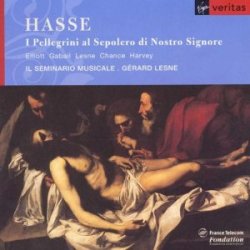Johann Adolf Hasse - I Pellegrini al Sepolcro di Nostro Signore (1998)
Johann Adolf Hasse - I Pellegrini al Sepolcro di Nostro Signore (1998)

1. I Pellegrini al Sepolcro di Nostro Signore, Parte Prima: Sinfonia 3:15 2. I Pellegrini al Sepolcro di Nostro Signore, Parte Prima: Recitativo: Di Solima distrutta lo squallore (Eugenio) 1:02 3. I Pellegrini al Sepolcro di Nostro Signore, Parte Prima: Aria: Del cammin più lo stento non sento (Eugenio) 4:27 play 4. I Pellegrini al Sepolcro di Nostro Signore, Parte Prima: Recitativo: Grazie a quel Dio che della nostra carco (Teotimo) 1:09 5. I Pellegrini al Sepolcro di Nostro Signore, Parte Prima: Aria: Senti 'l mar l'Onnipotente 5:35 6. I Pellegrini al Sepolcro di Nostro Signore, Parte Prima: Recitativo: A chi di cuor l'invoca (Albino, Teotimo, Agapito, Eugenio, Guida) 2:51 7. I Pellegrini al Sepolcro di Nostro Signore, Parte Prima: Aria: Non così cervo assetato (Agapito) 6:48 8. I Pellegrini al Sepolcro di Nostro Signore, Parte Prima: Recitativo: Quanto scorgete intorno, alme fedeli (Guida) 1:23 9. I Pellegrini al Sepolcro di Nostro Signore, Parte Prima: Lauda: Le porte a noi dissera (Albino, Teotimo, Agapito, Eugenio, Guida) 4:03 10. I Pellegrini al Sepolcro di Nostro Signore, Parte Seconda: Recitativo: Il Getsemani è questo (Guida, Eugenio) 1:47 11. I Pellegrini al Sepolcro di Nostro Signore, Parte Seconda: Aria: Era amor quei che dal fronte (Eugenio) 5:38 12. I Pellegrini al Sepolcro di Nostro Signore, Parte Seconda: Recitativo: Costi di tosco infetto (Guida, Agapito, Albino, Teotimo, Eugenio) 2:52 13. I Pellegrini al Sepolcro di Nostro Signore, Parte Seconda: Aria: D'aspri legato (Guida) 7:29 14. I Pellegrini al Sepolcro di Nostro Signore, Parte Seconda: Recitativo: Barbari, oimé! fermate, e in me volgete (Teotimo, Guida, Agapito) 7:02 15. I Pellegrini al Sepolcro di Nostro Signore, Parte Seconda: Aria: Viva fonte sia la fronte (Agapito) 6:38 16. I Pellegrini al Sepolcro di Nostro Signore, Parte Seconda: Recitativo: Dall'horror de' miei falli, e dal castigo (Teotimo, Eugenio, Albino, Guida) 3:49 17. I Pellegrini al Sepolcro di Nostro Signore, Parte Seconda: Aria: Scaccia l'orror, le tenebre (Teotimo) 4:44 18. I Pellegrini al Sepolcro di Nostro Signore, Parte Seconda: Coro: Pellegrino è l'uomo in terra 4:41 play Rachel Elliott, soprano Valérie Gabail, soprano Gérard Lesne, alto Michael Chance, alto Peter Harvey, basse Il Seminario Musicale Gérard Lesne - conductor, 1998
... the 18th C, of course! The Enlightenment, the Age of Reason, when most of the driving social and political thoughts of modern times were first stated - natural rights, liberty, equality, privacy! When the shackles of aristocracy, theocracy, and the divine right of kings were loosened! When scientific secular humanism began to blow away the smoke and stench of superstition and to declare knowledge a boon rather than a sin! When it was first hinted that squalor and misery were not ordained for the mass of humanity but rather might be mitigated by human effort! The Age of the Democratic Revolution, as Palmer called it, the time of the greatest events in European history, the American and French Revolutions, the birth of modern society. The century that saw brute muscle supplanted by machine power, alchemy transformed into chemistry, feudal authority replaced by the rule of law! The century that began the fearsome tasks of ending slavery and serfdom, and of extending human dignity to women! The greatest century of human progress...
...was also the greatest century of musical genius: Scarlatti, Vivaldi, Telemann, Bach and Bach's sons, Rameau, Handel, Gluck, Haydn, Boccherini, Mozart, and... Johann Adolf Hasse (1699-1783), probably the most successful and widely-known composer of his era, writer of 60 operas and scores of other works, an international superstar at home in Naples, Venice, Vienna, Dresden, and Warsaw. The rediscovery of Hasse has been slow and fitful, given the massive competition for audience attention, but it is growing; if one could buy stocks in composers, I'd say that Hasse might be the hottest start-up on the market.
The oratorio recorded here, "Pilgrims at the Sepulcher of Our Lord," was first performed in Dresden in 1742. The libretto was the last work of Stefano Pallavicini, who died a few days after the premier. Pallavicini was as acclaimed in his lifetime as Hasse, and this libretto was instantly declared his masterpiece. The characters are four pilgrims and a hermit guide, who visit the sacred sites of Jerusalem and meditate in recitativos and arias about their spiritual impact. Judging by the number of surviving editions and manuscripts, this oratorio was among the most frequently performed compositions of the century.
Scored for strings, flutes, oboes and bassoons, with five soloists who also act as chorus, this is a show-piece of galant vocal ornamentation and elegant orchestration, a work which openly equates beauty with sprituality. The influence of Alessandro Scarlatti, Hasse's teacher, is still obvious, but Hass transcends his master in structural variety and dramatic timing. The "lauda" at the end of the first act - a simulation of a a joyful procession into the Holy City - is a brilliant innovation in the oratorio format, with a lacy polyphony of the utmost Germanic compositional rigor yet with Mediterranean simplicity and charm.
This performance by Il Seminario Musicale could not be better. The four pilgrims, sung by two women sopranos and two male altos, are rapturously eloquent in their testimonies of musical devotion. The hermit guide, sung by bass Peter Harvey, delivers his sermon-arias with serenity rather than gloom, and with consummate vocal agility for a bass. Director Gerard Lesne himself sings the role of Teotimo, one of the pilgrims; his aria at the end of the second act (Scaccia l'orrore, le tenebre il lume tuo dal cielo) depicts the light streaming from Heaven, inviting "us" to partake of life, and believe me, that's what it sounds like! --- Giordano Bruno, amazon.com
download: uploaded anonfiles yandex 4shared solidfiles mediafire mega filecloudio nornar
Zmieniony (Piątek, 27 Grudzień 2013 16:29)








